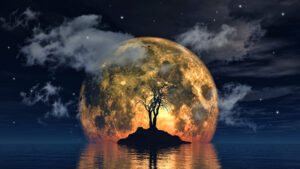
Stargazers are in for another treat in August! The most significant lunar phenomenon of the year is happening for a second time this month, also known as the super blue moon. Depending on your location, you can catch sight of the super blue moon either on August 30 or 31. Let’s explore the enchanting details of this celestial event that paints the night sky with a mesmerizing blue hue.
Unraveling the Phenomenon of Blue Moon Light Sky
The term “blue moon” might evoke images of a moon bathed in a cerulean glow, but the reality is even more fascinating. A blue moon refers to the occurrence of a second full moon within a single month, a rare event that graces our skies every few years. This time around, the awe-inspiring blue moon coincides with the term “super,” indicating its proximity to Earth.

The Moon’s Dance with Earth: A Closer Look at the Super Blue Moon
As the super blue moon takes center stage in the cosmic theater, it will be at its closest point to our planet. This cosmic rendezvous places the moon just 357,344 kilometers away from Earth. Alongside this magnificent sight, the planet Saturn will make a guest appearance, a radiant point of light positioned approximately five degrees above the moon’s upper edge.
Timing is Everything: When and Where to Witness the Blue Moon Light Sky
The anticipation builds as the clock ticks toward the moments when the blue moon graces our skies. In the realm of India Standard Time (IST), the super blue moon is set to manifest around 9:30 pm on August 30, showcasing its ethereal beauty. By the morning of August 31, at approximately 7:30 am IST, the blue moon will earn its “super” title. For those following Eastern Daylight Time (EDT), the optimal viewing times are 8:37 pm on August 30 or 6:07 am IST on August 31.
Unveiling the Magic: Understanding the Super Blue Moon’s Origins
The magic of the super blue moon lies in its celestial mechanics. Earth’s only natural satellite, the moon, follows an elliptical path around our planet. During its closest approach to Earth, known as perigee, the moon becomes a super moon, appearing larger, fuller, and more brilliant than usual. The “blue moon” term, however, doesn’t signify the moon’s color. Rather, it’s attributed to the occurrence of two full moons within a single month.
A Glimpse into Rarity: Super Blue Moon’s Infrequent Encore
While blue moons and super moons are not entirely uncommon, their convergence in a single event is a spectacle reserved for select moments. The universe treats us to a dual marvel approximately once every decade. So, this August’s super blue moon, gracing the night sky on August 30 (IST), is a cosmic rarity that should not be missed.
Looking Beyond: The Future of Super Blue Moons
As the super blue moon takes its bow and fades into the night, we’re left with anticipation for its next appearance. The next occurrence of this enchanting fusion of a blue moon and a super moon is not expected until January 2037. This elongated gap underscores the uniqueness of the upcoming event, making it a celestial show that’s worth every stargazer’s attention.
Conclusion: The Blue Moon Light Sky’s Allure
The August super blue moon paints a vivid picture in the night sky, reminding us of the wonders that lie beyond our earthly realm. Whether you’re a seasoned astronomer or a casual observer, this event offers a chance to connect with the universe in a profound way. So, mark your calendars and prepare to be captivated by the blue moon’s radiant glow as it graces the canvas of the night sky.
Frequently Asked Questions About the Blue Moon Light Sky
1. Will the blue moon actually appear blue in color? No, the term “blue moon” refers to the second full moon occurring within a month, not its color. The moon’s hue remains unchanged.
2. What’s the significance of the term “super” in a super blue moon? The term “super” indicates that the moon is at its closest point to Earth during this phase, resulting in a larger and brighter appearance.
3. Are blue moons and super moons frequent occurrences? Individually, yes. However, the convergence of both events, as in the case of a super blue moon, is a rare phenomenon.
4. Can the blue moon light sky be observed from any location? Yes, the blue moon light sky can be observed from various parts of the world, but the timing may vary.
5. When can we expect the next super blue moon after August 2023? The subsequent occurrence of a super blue moon is projected for January 2037, making this upcoming event a truly exceptional cosmic spectacle.
- for more exciting news visit-www.com373news.com
- BOOKS written by author-i)love beyond age
Низкие цены на мебель для дома
светильники уличные купить https://www.lu15.ru/sortament/ulichnye.
Сделайте заказ на памятник в Минске!
надгробие из гранита https://www.belnovosti.by/novosti-kompanij/chto-nuzhno-znat-o-vybore-pamyatnika-k-radonice/.
Опытные юристы – качественные и надежные консультации
советы юриста бесплатно http://www.konsultaciya-advokata-msk495.ru/.
10 полезных советов по худению дома
как похудеть мужчине в домашних условиях быстро http://hudetdoma12.ru/.
Использование программ 1С на базе облака
1с розница облако http://423clouds.ru/.
Каркасные дома: экономия материалов и трудозатрат
каркасные дома санкт петербург https://karkasnye-doma-pod-klyuch78.ru.
Каркасные дома в продаже – цена и качество
каркасные дома проекты и цены http://www.karkasnye-doma-pod-klyuch77.ru/.
Thanks for sharing. I read many of your blog posts, cool, your blog is very good.
thank you